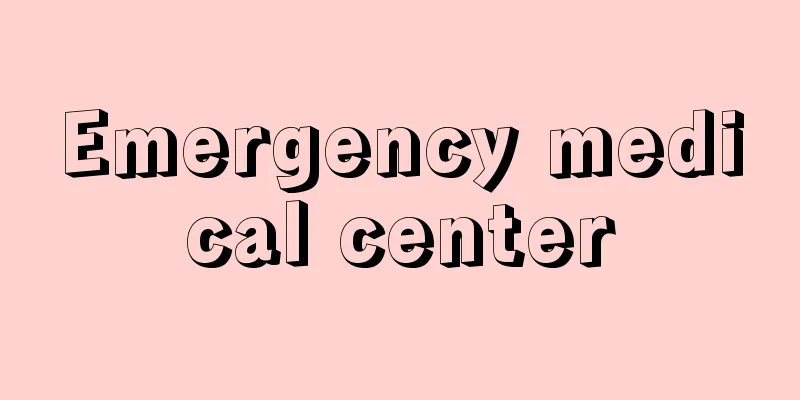Emergency medical center

|
A medical institution that provides advanced medical care to critical emergency patients. The emergency medical system is based on the division of roles among primary, secondary, and tertiary emergency medical institutions. Tertiary emergency medical institutions are medical institutions that provide comprehensive advanced medical care to critical emergency patients across multiple medical fields who cannot be treated at secondary institutions, and are called emergency medical centers. The goal is to have one for every 1 million people, and as of April 2019, there were 290. Advanced emergency medical centers are facilities that accept patients with special diseases, such as extensive burns, finger amputations, and acute poisoning, among patients admitted to emergency medical centers, and 42 have been established, but it has been pointed out that the position is unclear (Report of the Study Group on the State of the Emergency Medical System, etc., 2014), and a review of the requirements is being considered. According to the Guidelines for the Implementation of Emergency Medical Care Measures established by the Ministry of Health, Labor and Welfare, the purpose of emergency medical centers is to ensure medical care for seriously ill patients through a system of smooth cooperation between first-stage emergency medical facilities such as emergency centers for night and holiday patients, on-call doctor systems, second-stage emergency medical facilities such as hospital group rotation systems, and emergency patient transport organizations. The Emergency and Critical Care Center's operating policy is based on the following four points. (1) In principle, the hospital will accept all critical emergency patients, including those with severe conditions across multiple medical specialties, on a 24-hour basis. (2) It is a rear hospital for primary and secondary emergency medical facilities, and in principle, accepts emergency patients from these medical facilities and emergency transport services on a 24-hour basis. (3) For patients who have received appropriate emergency medical care and are deemed to be in a state where their lives are no longer in danger, we will proactively transfer them to beds in affiliated hospitals or to the medical facilities from which they were transferred, so that we always have enough hospital beds available. (4) Provide clinical education in emergency medical care to medical students, clinical trainees, physicians, nursing students, nurses, emergency medical technicians, etc. The main maintenance standards for emergency medical centers are as follows: (1) Have dedicated beds (generally 20 or more beds) and provide advanced medical care for all critical emergency patients, including those with severe conditions across multiple medical specialties, on a 24-hour basis. (2) To ensure a 24-hour medical system, the necessary staff will be deployed. Specifically, there will be an appropriate number of full-time doctors (Japanese Society of Acute Medicine instructors and specialists) who have been objectively evaluated as being knowledgeable in specialized tertiary emergency medical care, and a system will be in place to ensure that doctors from other departments can be secured as needed. The changes in the social environment surrounding emergency medical centers and the main current issues include the following: (1) Occurrence of cases where it is difficult to accept emergency transport The number of emergency transports has increased by about 490,000 cases in the five years from 2012 to 2017. Looking at the number of people transported due to sudden illness, the proportion of patients with minor symptoms (outpatient treatment only) is high, accounting for about 48.1%. Due to the time lost in responding to unnecessary and non-urgent use, there is concern that there will be delays in responding to patients with more urgent injuries. According to the 2017 Survey on the Acceptance Status of Medical Institutions in Emergency Transport by the Fire and Disaster Management Agency of the Ministry of Internal Affairs and Communications and the 2018 Fire and Disaster Management Agency White Paper, 2-3% of cases involved inquiries to hospitals four or more times to select a medical institution to accept patients, and around 3-8% of cases involved cases where a destination could not be found and the patient stayed at the scene for more than 30 minutes. In cases where it is difficult to transport patients with serious or more serious injuries, the main reasons for not being able to accept patients are that they are undergoing surgery or are attending to other patients, beds are full, and treatment is difficult. This is not a case of "passing the buck," but rather includes cases where patients who should have been admitted to secondary emergency medical facilities are instead transported to tertiary emergency medical facilities or emergency medical centers, and are unable to be admitted because the facilities' capacity is exceeded. Measures are needed that involve the entire emergency medical system, including primary and secondary emergency care. (2) Delay in strengthening hospital emergency response systems Emergency medical institutions have not made sufficient progress in strengthening their systems to accommodate the increase and diversification of emergency use, and issues include shortages of doctors, nurses, and paramedicals (healthcare workers other than doctors and nurses) who provide emergency medical care, as well as harsh working conditions. Emergency medical care is a field that is particularly required to be provided regardless of profitability, and there are limits to the ability of hospitals to secure personnel on their own. Strengthened public support is needed. (3) Increasing expectations for emergency medical care Patients' expectations and demands for emergency medical care are increasing, and the time and psychological burden on medical providers is increasing due to the need to respond to excessive expectations such as "I will definitely be saved if I go to the hospital. I have the right to receive highly specialized medical care anytime, anywhere, regardless of time or place." As well as concerns about the risk of litigation, government agencies are expected to implement measures that will deepen the understanding and cooperation of residents and patients. In light of the above situation, emergency medical centers are being given a "staged evaluation" to encourage them to further strengthen their functions and improve their quality. The pillars of this evaluation are the following four points: (1) Medical treatment functions for seriously and critically ill patients, (2) Support functions for the local emergency transport and emergency medical system, (3) Education functions related to emergency medical care, and (4) Disaster medical response functions. In addition to the above, other items that were evaluated included consideration of local characteristics such as situations where it takes a long time to transport patients to the nearest emergency medical center, items related to improving the working environment of medical staff such as reducing the burden on doctors, involvement in the Medical Control Council, and involvement in the emergency medical information system. Measures aimed at improving the emergency medical system are expected to be implemented in the future. [Yukihiro Maeda February 17, 2020] [Reference] |Source: Shogakukan Encyclopedia Nipponica About Encyclopedia Nipponica Information | Legend |
|
重篤な救急患者に高度な医療を提供する医療機関。救急医療体制は、初期、二次、三次救急医療機関の機能分担に基づき構築されている。三次救急医療機関とは、二次では対応できない複数の診療科領域にわたる重篤な救急患者に対し、高度な医療を総合的に提供する医療機関であり、それを救命救急センターという。おおむね人口100万人に1か所を目標に整備されており、2019年(平成31)4月の時点で290か所である。高度救命救急センターは、救命救急センターに収容される患者のうち、とくに広範囲熱傷、指肢切断、急性中毒等の特殊疾病患者を受け入れる施設とされており42か所整備されているが、位置づけが曖昧(あいまい)であるとの指摘もあり(平成26年救急医療体制等のあり方に関する検討会報告書)、その要件の見直しが検討されている。 厚生労働省が定めた救急医療対策事業実施要綱によると、救命救急センターは、休日夜間急患センター、在宅当番医制等の初期救急医療施設、病院群輪番制等の第二次救急医療施設、および救急患者の搬送機関との円滑な連携体制のもとに、重篤救急患者の医療を確保することを目的としている。 救命救急センターの運営方針は下記の4点である。 (1)原則として、重症および複数の診療科領域にわたるすべての重篤な救急患者を24時間体制で受け入れる。 (2)初期救急医療施設および第二次救急医療施設の後方病院であり、原則として、これらの医療施設および救急搬送機関からの救急患者を24時間体制でかならず受け入れる。 (3)適切な救急医療を受け、生命の危険が回避された状態にあると判断された患者については、積極的に併設病院の病床または転送元の医療施設等に転床させ、つねに必要な病床を確保する。 (4)医学生、臨床研修医、医師、看護学生、看護師および救急救命士等に対する救急医療の臨床教育を行う。 救命救急センターのおもな整備基準は下記の内容である。 (1)専用病床(おおむね20床以上)を有し、24時間体制で、重症および複数の診療科領域にわたるすべての重篤な救急患者に対する高度な診療機能を有する。 (2)24時間診療体制を確保するために、必要な職員を配置する。具体的には、専門的な三次救急医療に精通しているとの客観的評価を受けている専任の医師(日本救急医学会指導医および専門医)を適当数有すること、および他科の医師を必要に応じ適時確保できる体制を有すること。 救命救急センターをめぐる社会環境の変化や現状のおもな課題としては、以下のような点があげられる。 (1)救急搬送の受入れ困難事案の発生 (2)院内の救急受入れ体制強化の遅れ (3)救急医療に対する期待値の増大 前記のような状況を踏まえ、救命救急センターに対しては、機能の強化や質の向上へのいっそうの取組みを促すために「充実段階評価」が実施されている。この評価の柱は以下の4点にある。 (1)重症・重篤患者に係る診療機能、(2)地域の救急搬送・救急医療体制への支援機能、(3)救急医療に関する教育機能、(4)災害医療への対応機能の4点である。 以上のほかに、最寄りの救命救急センターへの搬送に長時間を要するような状況(地域特性)の勘案、医師の負担軽減など医療従事者の労働環境改善に係る項目、メディカルコントロール協議会への関与、救急医療情報システムへの関与などの項目も評価されている。今後の救急医療体制の充実に向けた対策が期待される。 [前田幸宏 2020年2月17日] [参照項目] |出典 小学館 日本大百科全書(ニッポニカ)日本大百科全書(ニッポニカ)について 情報 | 凡例 |
Recommend
Ribosomal RNA
...The mechanism that controls mRNA synthesis, wh...
Dino Campana
Italian poet. He began writing poetry while study...
Affective incontinence
This refers to a state in which emotions cannot be...
ICC - Inter-Computer Security
《 International Color Consortium 》An international...
Yan Fu
Born: 1853 [Died] 1921 A Chinese thinker and trans...
Trauner, A. (English spelling) TraunerA
...In contrast to this, Lazare Meerson (1900-1938...
Elevation (English spelling)
...used mainly in France, especially at the Paris...
Amsha Spanta - Amsha Spanta
…Its doctrine has strong eschatological overtones...
Power supply - Kyuden
It refers to the comprehensive management of each...
Logic circuit
A general term for circuits that have the function...
Perilymphatic fistula
What is the disease? Located between the middle a...
Armand Salacrou
French playwright. Born in Rouen on August 8th as...
Oshamanbe [Hot Spring] - Oshamanbe
...Dairy farming is the main agricultural industr...
Yasuji Otsuka
1869 * - 1931 An aesthetician from the Meiji to e...
Ixeis debilis (English spelling) Ixeisdebilis
… [Morita Tatsuyoshi]. … *Some of the terminology...









